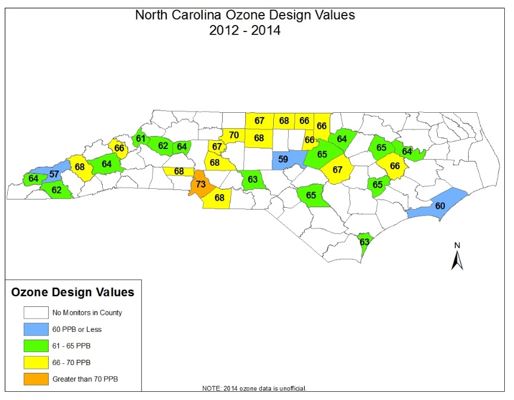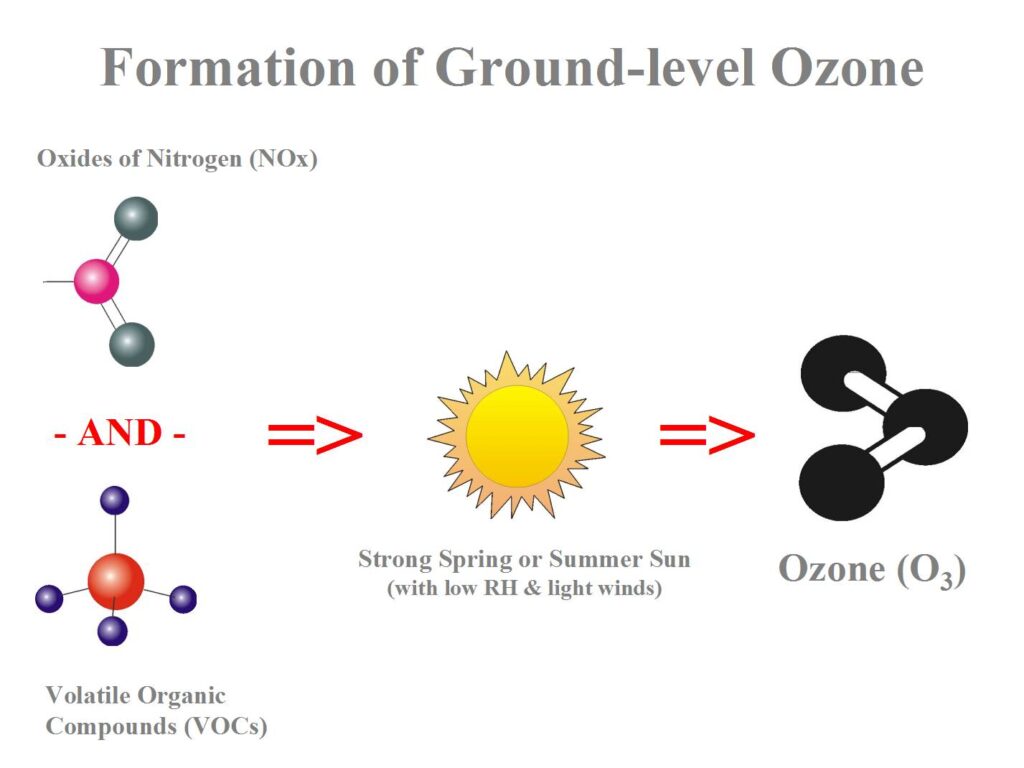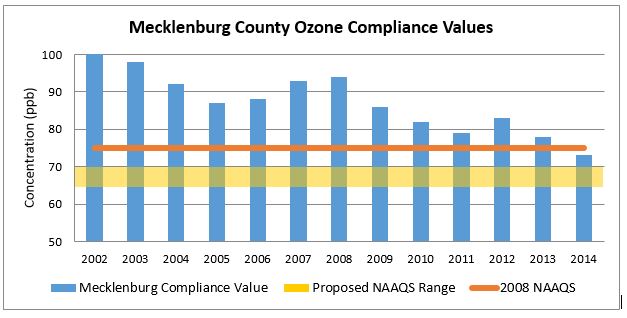Air quality standards likely to become stricter soon
Air quality in our region has improved, but coming changes will likely put Mecklenburg County out of compliance with more stringent standards. At the April 2 Technical Coordinating Committee of the Charlotte Regional Transportation Planning Organization, Megan Green of Mecklenburg County Air Quality presented information about a proposal by the US Environmental Protection Agency (EPA) to lower the health-based National Ambient Air Quality Standard (NAAQS) for ground-level ozone to a value between 65-70 parts per billion (ppb). The current standard, set in 2008, is 75 ppb. The new standard would be approved by October 1.

Yikes! Mecklenburg County has the highest ground-level ozone in the state.
Source: http://daq.state.nc.us/planning/ozone/
Ground-level ozone is worst in the summer months because it forms due to a chemical reaction of pollutants emitted from industrial processes and vehicle emissions in the presence of sunlight. Breathing in high levels of ground-level ozone can cause acute respiratory problems such as coughing and respiratory irritation and can aggravate the symptoms of asthma.

Ground-level ozone forms when pollutants from vehicles and industry react in the presence of sunlight.
We’re in favor of the more stringent proposed standard because our region’s residents deserve to breathe clean, healthy air. It’s as simple as that. But meeting that standard will be much more difficult. As you can see in the graph below, Mecklenburg County was in compliance (for the first time in 12 years!) with the current ozone standards at the end of the 2014 ozone season. The current standard is shown as the red horizontal line. The yellow line below it shows the range of the proposed new standard.

Mecklenburg County met the ozone standard in 2014, but would not meet the new proposed standard. Source: Mecklenburg County Air Quality
Can you see the problem? In no year since 2002 has Mecklenburg County been close to falling within the proposed new standard. This means that we will very likely be out of compliance if the new standard is adopted. Over the next few years, data will be collected to determine whether we are a “non-attainment” area. The earliest deadline for non-attainment areas to meet the standard would be October 2020.
*****
Wondering how to protect yourself and your loved ones from the effects of ground-level ozone? Here are some suggestions:
1. Be informed. The NC Division of Air Quality maintains a Air Quality Forecast page that ranks today’s and tomorrow’s air quality on a simple color-coded map from Good (green) to Very Unhealthy (purple). Learn more about Mecklenburg County’s air quality on pages 7 through 10 of our 2014 Charlotte-Mecklenburg Sustainability Report Card.
2. Protect vulnerable lungs. When ground-level ozone levels are high, respiratory problems are more likely. This is not healthy for anyone, but it’s especially problematic for the elderly and people with cardiac or respiratory conditions such as asthma and heart disease. Children are also vulnerable because their lungs are still developing and they breathe in a higher volume of air per pound of body weight than adults. Using the forecast tool above, monitor the air quality in your region. If it’s in the high range, limit outdoor activities. Learn more tips to protect yourself at the American Lung Association website.
3. Become part of the solution. In Mecklenburg County, most of the smog-forming emissions (ozone is a pre-curser to smog) come from vehicles. Although today’s vehicles emit far fewer pollutants than vehicles built decades ago, our area is near the top of the list for the fastest population growth in the nation. More residents will mean more and more vehicles emitting air pollutants, unless we change the ways we travel. Visit our Transportation Choices Alliance website to find many ideas and resources for traveling by foot, bicycle and transit.
Acknowledgment: Thank you to Megan Green of Mecklenburg County Air Quality for providing the figures and information about the proposed standard.
Thanks for reading!
As a nonprofit, community support is essential for us to keep doing what we do — including providing free articles like this. If you found this article helpful, please consider supporting Sustain Charlotte.
Want to stay in the loop? Subscribe to our weekly newsletter and follow us on Instagram, Facebook, and Twitter.
